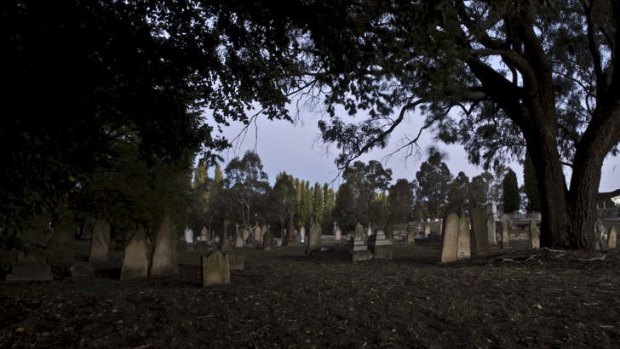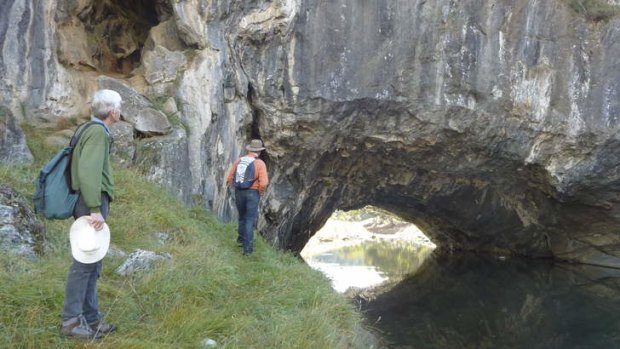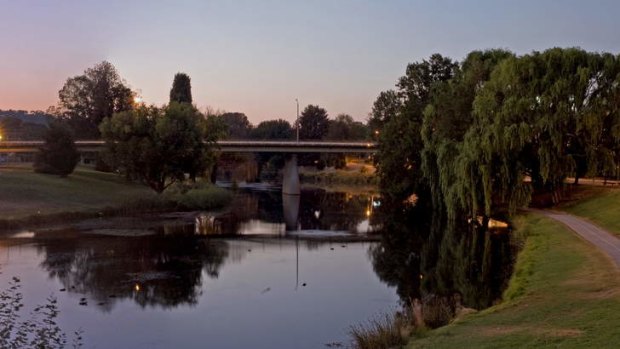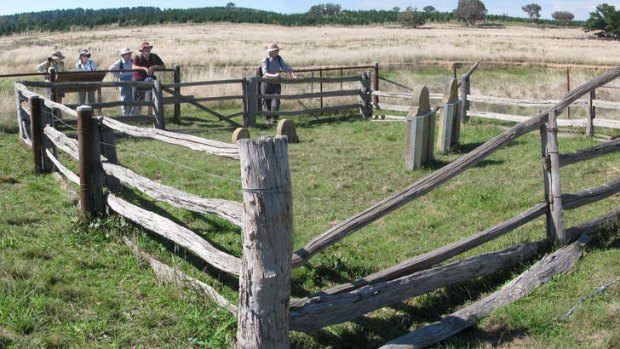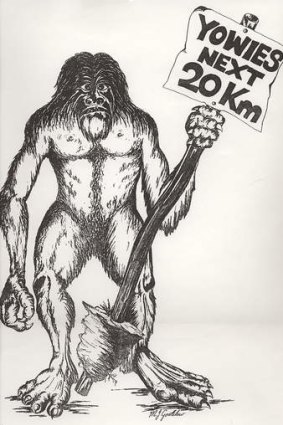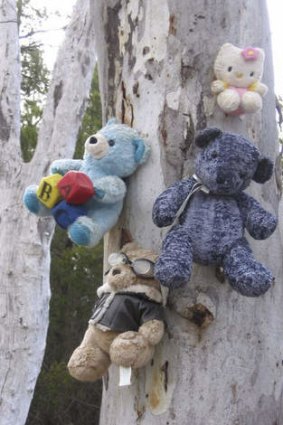Respect the lore (original) (raw)
September 20, 2013 — 4.50pm
Queanbeyan's Riverside Cemetery.Credit: Trudy Taylor
While we Canberrans have been busy blowing out candles and floating fanciful hot-air balloons to mark our centenary, the good folk of Queanbeyan across the border have been gearing up for their own big bash - on September 28, our neighbouring city turns 175.
As part of the city's festivities, parochial Queanbeyan author Nichole Overall will launch her eagerly awaited book, Queanbeyan: City of Champions. Five years in the writing, what began as just a salute to her town's extraordinary honour roll of sporting heroes has morphed into a comprehensive chronicle of Queanbeyan's sporting, social, cultural and historical fabric.
The lavishly illustrated (top marks to photographer Trudy Taylor) coffee-table book is under wraps, but I scored a sneak peek. I'm already well versed in the achievements of sporting stars such as Mark Webber, David Campese and Heather McKay (the Don Bradman of the squash world), so, given my penchant for the unexplained, it was the chapter titled ''Myths, Legends and Mysteries'' that caught my eye. Overall confesses she really enjoyed penning this section because so many of the stories ''are passed around town by word of mouth, but until now haven't been collated and published before''.
Exploring London Bridge.Credit: Tim the Yowie Man
So, today, in the lead-up to their 175th birthday bash, with reference to Overall's terrific tome, I present my top 10 myths, legends and mysteries of Queanbeyan.
1. Secret tunnel
While there are tales aplenty of subterranean passageways criss-crossing Canberra's Parliamentary Triangle, Queanbeyan also lays claim to its own secret tunnel. Stretching the length of the Queanbeyan central business district from the western end to the river, with ventilators and a manhole, is a wooden-walled tunnel that was built in 1886 to mitigate flood problems. According to Overall, ''long since sealed, at one time access was unrestricted and local teenagers would compete to see who would dare to go the furthest along the darkened, bat-infested stretch''.
Queanbeyan River at dusk.Credit: Trudy Taylor
Do you know anyone who has crawled through the tunnel? I'd love to know. Apparently, you can see the tunnel's exit into the river not far from the Queens Bridge in the town's main street.
2. Hidden treasure
During the mid-1800s, the Queanbeyan region was on the hit-list of many bushrangers. Local lore has it that after one of his hold-ups, Frank Gardiner - sometimes referred to as ''the father of bushranging'' - hid at his sister and niece's home near Queanbeyan. ''While this alleged stay is unverified, the 1862 heist, in which Gardiner's gang held up a transport coach on its way to Bathurst, was factual and is recorded as having netted the equivalent of $12.5 million,'' reveals Overall, who adds that ''some of the gold was eventually recovered near Forbes, but what happened to the remaining loot is a matter of intrigue''.
The Colverwell Graves.Credit: Max Lawrence
3. Bushranger booty
Another bushranger to wreak havoc in the Queanbeyan district was William Westwood, known affectionately as ''Jackey Jackey''. Overall says ''he garnered attention for his peculiar habit of leaving those he robbed in a state of undress''. Mmm … I wonder if that could explain the next mystery?
4. Hairy men
Yowies are entrenched in Queanbeyan folklore. Sketch: Myles Gostellow.
The bush on the outskirts of Queanbeyan has long been a supposed haunt of the yowie. In 1912, The Queanbeyan Age reported that war hero and politician Colonel Ryrie heard stories of the creature since he was a child, and sightings were given weight by civic leader and businessman John Gale in his 1927 book, Canberra: History of and Legends Relating to the Federal Capital Territory of the Commonwealth of Australia. Interest in the elusive beast peaked in the mid-1970s, when the Queanbeyan Festival Board offered a $200,000 reward for the capture of a yowie after a man claimed he was confronted by a ''six foot tall, dark grey, hairy creature with its head merging into its shoulders'' near Googong Dam. The reward has yet to be claimed, but a Queanbeyan basketball club has adopted the hairy beast as its official mascot.
5. Phantom python
Not far from Googong Dam is London Bridge, an impressive naturally occurring rock bridge spanning Burra Creek. On the southern side of the arch is a small cave whose entrance is guarded by a rock formation that resembles a giant serpent's head. In the late 1800s, there were tales that the cave was filled with hundreds of human bones. While records show that a local policeman did indeed discover skeletal remains in 1874, by the time the coroner arrived, the bones had vanished.
Teddies on a tree between Queanbeyan and Bungendore.Credit: Hilary Talbot
6. Coffin mystery
In 1974, a flood eroded the corner of the Queanbeyan Riverside Cemetery, washing away more than 60 coffins and their contents. ''Legend has it that the bones are still embedded in the mud at the bottom of Canberra's Lake Burley Griffin, into which they would have been washed,'' Overall writes.
7. Out-of-place creatures
In recent floods, innovative locals have circulated photographs of crocodiles left high and dry in the town's main street. While these have been of the plastic, inflatable variety, Overall says there are many stories of giant Murray cod left floundering in the main street, long after floods have subsided. As an indication of just how much water washes through the centre of Queanbeyan during a flood event: in December 2010, heavy rain and a full Googong Dam led to the discharge of 700 cubic metres a second; that's four times the flow over Niagara Falls.
8. Strange spectres
Many generations of Queanbeyan teenagers have been dared to walk in the dead of the night to the Air Disaster Memorial just on the ACT side of the NSW border. The site has the unenviable reputation of being one of our region's most haunted following the August 1940 crash of a Lockheed Hudson bomber, in which 10 poor souls lost their lives. Did you know it was former Queanbeyan resident Les McIntyre (1915-2009), founding chairman of the Canberra Raiders, who was first person on the scene of the burning wreck?
9. Teddies in the trees
In recent decades, teddy bears nailed to the trees between Queanbeyan and Bungendore have mystified many a motorist. Overall cites the Monument Australia website theory that this puzzling phenomenon started as a single bear attached to a tree following the death of a child in a car accident. ''When more appeared, council apparently removed them, only to be replaced by growing numbers,'' Overall says. The line of teddies now reaches all the way to Batemans Bay (and beyond!). Photo blogger Hilary Talbot, who has photographed many of the teddies, says she ''likes that the number is growing gradually'', and especially ''enjoys photographing the weathering patterns and process on the teddies, and how it changes their character''.
10. Baffling disappearances
In 1896, 21-year-old Queanbeyan resident Kate Donnelly went missing without trace. More than three weeks later, she was found ''exhausted, starved almost to death, helpless and unable to speak - and yet still wearing her gloves.'' Apparently, she'd been robbed and left for dead by an unnamed assailant. The town's chief constable, Thomas Webber, wasn't so lucky. In 1853, he was recorded as dying and being buried; however, it was later reported that Webber's grave had been inspected and there was not sufficient evidence that he'd been buried. ''Whatever his fate, Webber was certainly no longer around to attest to it,'' Overall muses.
FACT FILE
Queanbeyan City of Champions: Nichole Overall's coffee table book (photographed by Trudy Taylor) will be launched this Thursday before an invitation-only crowd of more than 300 Queanbeyan luminaries. It is available at selected bookshops ($49) and also at qbncityofchampions.com.au
Queanbeyan's 175th celebrations: Queanbeyan's 175th birthday bash will be held on the banks of the Queanbeyan River, as well as around the new Sensory Garden in Ray Morton Park, Saturday, September 28. See qcc.nsw.gov.au.
Tim's tip: Near the centre of town, perched on a grassy knoll overlooking the river is the idyllic Riverbank of Queanbeyan cafe (4 Trinculo Place). Run by Brent Richter (formerly of The Oaks Brasserie in Yarralumla), it's a sunny spot to enjoy a cuppa on a lovely spring day, and if you've got kids they will love to frolic on the adjoining strip of sand known affectionately by locals as ''the beach''. Also, keep an eye out for platypuses, often spotted from the cafe's al-fresco dining area.
PLAN AHEAD FOR
What: Glenburn and Burbong Historic Sites Walk (near Queanbeyan) with the National Parks Association of the ACT (and Friends of Glenburn).
When: Sunday, September 29, from 9am.
Expect: A leisurely drive/walk back into Canberra/Queanbeyan's early European history. Visit the ACT's oldest marked European graves (1837), the oldest operating shearing shed, the site of a public school and charcoal kilns. The tour will also include the stone ruin of Colliers Homestead, built for George Campbell of Duntroon in 1880, on land he didn't even own.
Did you know? Charcoal from the Glenburn kilns was used to help power the Commonwealth truck fleet during World War II (as a substitute for petrol).
Sign up for the Traveller newsletter
The latest travel news, tips and inspiration delivered to your inbox. Sign up now.
Most viewed on Traveller
Loading
